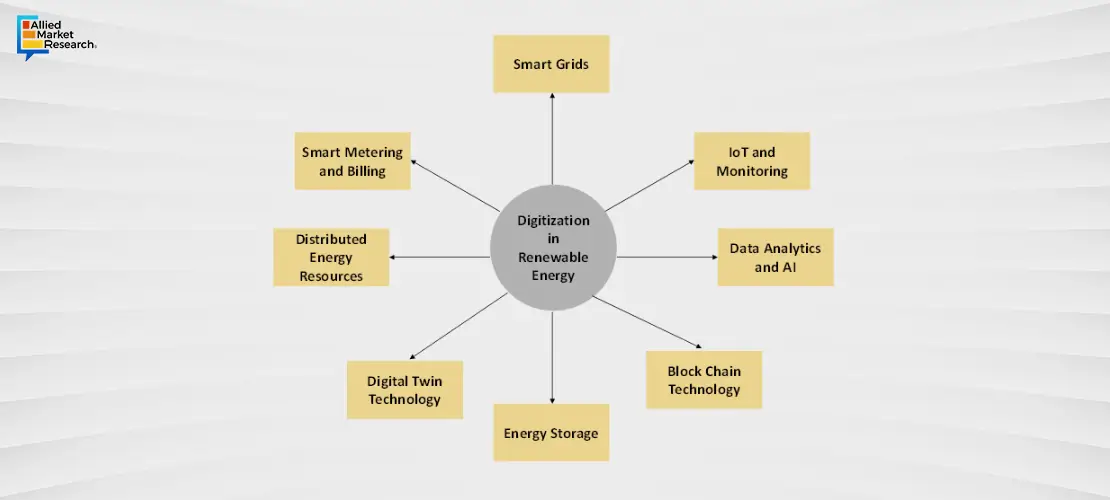Role of Digitization in the Renewable Energy Sector

Clean energy transition requires a fundamental transformation of power systems, including much higher levels of digitalization at scale across all grid domains, from generation to transmission and distribution to end-use. The energy sector faces a necessary need to minimize carbon emissions and enhance electricity accessibility, especially in low-income areas, for instance by using clean hydrogen sources.
There are several major problems faced by the renewable energy sector such as geographically dispersed energy data, lack of integrated platforms, inability to track assets, and other such problems. Digital technologies offer solutions to enhance climate impact, enhance power system resilience, and ensure cost-effective energy delivery. Digitalization plays a crucial role in advancing and optimizing various factors of renewable energy, contributing to its growth and effectiveness. Digitization equipment and systems in renewable energy improve automatic processes and minimize downtime. Indeed, the urgent need to address climate change and enhance energy access, specifically in low-income communities, requires innovative and sustainable solutions.
Digital technologies play a crucial function in the energy sector's transition toward decarbonization and increased accessibility. The below determine depicts some prominent factors by which digitalization is expected to contribute towards growth in the renewable energy sector.
- Smart Grids: Digital technologies allow smart grids to efficiently manage the generation, distribution, and consumption of renewable energy. This ensures a smoother integration of variable energy sources like solar and wind, enhancing grid reliability.
- Internet of Things (IoT) devices allow for real-time monitoring of renewable energy assets such as solar panels and wind turbines. This enables quick detection of issues, predictive maintenance, and optimal performance.
- Data Analytics and AI: Advanced analytics and artificial intelligence enhance the efficiency of renewable energy systems by inspecting large datasets. This optimization leads to better forecasting, improved energy production, and cost reductions. AI in energy has been gaining much importance.
- Blockchain Technology: Blockchain can be employed for transparent and secure transactions in renewable energy markets. This ensures traceability of renewable energy generation, facilitating trust among stakeholders and reducing fraud.
- Energy Storage: Digital technologies contribute to the efficient management of energy storage systems, allowing for better integration of intermittent renewables and ensuring a stable power supply.
Power System Digitization is Crucial for Efficiency and Decarbonization
Since the cost of unreliable grids is excessive and due to electricity outages, companies in rising markets and developing economies function below capacity each year and pay for backup electricity generation. One of the advantages of digitization in power systems is improvements in reliability. As per the research conducted by Allied Market Research, digitization is expected to increase the demand for various renewable energy systems by more than 25% by the end of 2030. The primary reason associated with the growth is based on increased system effectivity and reduced cost for customers with the use of digital-enabled renewable energy systems.

Prominent Investments Related to Digitization in Renewable Energy
As per Allied Market Research analysis, investment related to digitization is expected to increase at a year-on-year growth of more than 15% till 2032. The growth in digitization is supported by various factors such as increased investment in digital-related grid technologies, expanded EV charging infrastructure, and investment by transmission system operators and distributed system operators in analytics for grid operation and power quality. The below figure depicts investment in digital-related grid technologies till 2022.
Globally, current investment in grids is far short of the level needed to be on track for net zero globally. Annual investment in grids will need to more than double from around US$ 330 Bn per year to US$ 750 Bn by 2030, with around 75% of the investments allocated to the distribution grids to expand, strengthen, and digitalize technologies.
Country and Regional Highlights
- The European Union launched an action plan for Digitalizing the energy system in 2022 to promote connectivity and interoperability, foster coordinated investments in smart grid technologies, empower customers, enhance cyber security, promote greater efficiency, and design effective governance through joint planning.
- The United?Kingdom launched a ‘digital spine’ feasibility study in October 2022, as a follow-up to the Energy Digitalization Taskforce report initiated by the energy regulator (Ofgem), Innovate UK, and the Department for Business, Energy and Industrial Strategy.
- Many countries, including Brazil, India and South Africa, are seeing a rapid increase in the uptake of distributed solar photovoltaic (PV) systems. For example, in Brazil, distributed solar PV installed capacity rose by almost 7 GW in 2022, an increase of more than 50% in one year alone.
Analyst Viewpoint and Concluding Statement
The developed and developing nations are adopting digitization in renewable energy sector and are highly contributing towards the growth of the market during the forecast period. Measuring greenhouse gas emissions with AI enabled drones, accelerating energy transition and optimizing geothermal energy are the strategies being adopted by major players that are supporting digitization in renewable energy which may enhance the sector position and boost the growth of the renewable energy sector over the forthcoming years.



